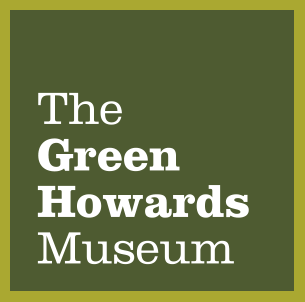
Alfred was born around June 1882 at Thornaby near Stockton, the son of Thomas Salmon, a foreman brewer. Alfred would eventually become an assistant grocer at Leyburn. Here he courted Lizzie Chiltern. Lizzie’s brother James had joined the West Yorkshire Regiment and was killed in June 1917 aged 20. It would appear that they never married as Alfred’s attestation form, when he signed up, has him as unmarried. The 1911 census has Alfred living in Leyburn as a boarder to a widow Catherine Pearson, aged 70.
He enlisted on the 8th April 1916 at Leyburn joining the 5th Battalion Yorkshire Regiment. By early 1917 Alfred had been wounded and was to spend the rest of 1917 and part of 1918 convalescing in England. He was discharged from the Army on the 15th April 1918, his rank being Lance Corporal. Alfred was now living in Waverley Terrace, Darlington. It was here that he died from pneumonia, exacerbated by his war wounds on the 16th February 1919 aged 36.
Alfred was buried in Darlington West Cemetery.
Explore more memories from the ribbon
-
Rear-Admiral Sir Christopher “Kit” George Francis Maurice Cradock KCVO CB SGM
Cradock was born at Hartforth, Richmond, North Yorkshire. After attending Richmond School, he entered the Royal Navy in 1875 he was promoted to rear-admiral in 1910. With the start of the First World War, in August 1914, Cradock, commanding the 4th Squadron of the Royal Navy and stationed at Stanley, had to deal with Admiral Maximilian von Spee’s East Asia Squadron. Cradock’s fleet was significantly weaker than Spee’s, consisting of mainly elderly vessels manned by largely inexperienced crews. The orders he received from the Admiralty were ambiguous, and Cradock interpreted them as instructing him to seek and engage the enemy forces; clarifying instructions were not issued until 3 November, by which time the battle had already been fought. Cradock found Spee’s force off Chile in the late afternoon of 1 November, and decided to engage, starting the Battle of Coronel. He tried to close the range to engage immediately, so that the enemy would have the setting sun in their eyes, but von Spee kept the range until dusk, when the British cruisers were silhouetted in the afterglow, while his ships were hidden by darkness. Cradock’s flagship HMS Good Hope and the HMS Monmouth were destroyed with the loss of all 1570 lives, including his own. A monument to Admiral Cradock was placed in York Minster. There is a monument and a stained glass window in Cradock’s memory in his parish church at Gilling West.
-
Private Percy Raworth
Percy Raworth was Judith Farrar’s grandfather’s cousin, she visited the museum to tell us his story. Percy Raworth was born in 1890 and attended Elmfield College in York. His father William ran a local building firm, and later became a local Councillor in Harrogate. By 1911 Percy was a Joiners’ apprentice and well on the way to joining the family firm. His career seems to have taken a side track as he was working as a ‘Stock Keeper’ at his brother-in-laws leather warehouse at Rushden, Northamptonshire when he enlisted. Originally a member of the Machine Gun Corps, Percy went on to serve with the Tank Corps, specifically, ‘D’ Brigade and win the Military Medal. The Rushden Echo of 10th November 1916 notes that he: Has been in action several times with the ‘Tanks’, once he was four hours under fire digging the ‘Tank’ out of a German dug-out into which it has sunk. On another occasion the ‘Tank’ caught fire, and Private Raworth and his driver got the military medal.’ Percy died on 23rd September 1917 of wounds he received during a German air raid. It seems that his tank again became grounded and whilst Percy was digging it out German aircraft attacked. Capt. F. A. Robinson wrote to Percy’s father: ‘…he was struck by an enemy bomb. He was made as comfortable as humanly possible under the circumstances, and you will doubtless find some consolation in the knowledge that he did not appear to feel very much pain……our experiences…
-
Henry Robinson
Kevin Robinson of Dalton on Tees visited the Green Howards museum to tell us about his great great grandfather, Sergeant Henry Robinson MM. Henry joined the Yorkshire Regiment (the Green Howards) as a very young man and soon left the UK to serve in the Boer War. Henry had several service numbers during his career with the earliest (and therefore a low number) being 421. On returning from the Boer war he then went to serve in the First World War both in France and Belgium, Henry and his division engaged in 2nd & 3rd Battle of Ypres, 1st & 2nd Battle of the Somme and the Battle of Arras to name a few. He is believed to have been a very accomplished horseman. His army career spanned some 4 decades as a Territorial reservist. During this time he picked up a proud chest-full of medals including the Military Medal awarded 10th October 1916. Adding a Bar to his MM in October 1918, other medals believed to be Queens South Africa Medal, 1914 Star, British War Medal, and Victory Medal with Oak Leaf (Mentioned in Despatches). Henry was also a Hero when not serving his country he was serving children with fun, Henry and his wife Elvira lived in a motor home at Derby Street / Cooper Street / Canon Street Common in Middlesbrough. They operated several fun fair rides which included swing boats and a roundabout. They continued to run the fun fair rides for several decades into the…
